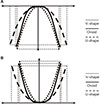1. Smith SS, Buschang PH, Watanabe E. Interarch tooth size relationships of 3 populations: “does Bolton’s analysis apply?”. Am J Orthod Dentofacial Orthop. 2000; 117:169–174.
2. Al-Khateeb SN, Abu Alhaija ES. Tooth size discrepancies and arch parameters among different malocclusions in a Jordanian sample. Angle Orthod. 2006; 76:459–465.
3. Ferrario VF, Sforza C, Colombo A, Carvajal R, Duncan V, Palomino H. Dental arch size in healthy human permanent dentitions: ethnic differences as assessed by discriminant analysis. Int J Adult Orthodon Orthognath Surg. 1999; 14:153–162.
4. Dalidjan M, Sampson W, Townsend G. Prediction of dental arch development: an assessment of Pont's Index in three human populations. Am J Orthod Dentofacial Orthop. 1995; 107:465–475.
5. Hassanali J, Pokhariyal GP. Anterior tooth relations in Kenyan Africans. Arch Oral Biol. 1993; 38:337–342.
6. Merz ML, Isaacson RJ, Germane N, Rubenstein LK. Tooth diameters and arch perimeters in a black and a white population. Am J Orthod Dentofacial Orthop. 1991; 100:53–58.
7. Hattab FN, al-Khateeb S, Sultan I. Mesiodistal crown diameters of permanent teeth in Jordanians. Arch Oral Biol. 1996; 41:641–645.
8. Nummikoski P, Prihoda T, Langlais RP, McDavid WD, Welander U, Tronje G. Dental and mandibular arch widths in three ethnic groups in Texas: a radiographic study. Oral Surg Oral Med Oral Pathol. 1988; 65:609–617.
9. Townsend GC, Brown T. Heritability of permanent tooth size. Am J Phys Anthropol. 1978; 49:497–504.
10. Garn SM, Lewis AB, Kerewsky RS. Sex difference in tooth size. J Dent Res. 1964; 43:306.
11. Jacobson A. The craniofacial skeletal pattern of the South African Negro. Am J Orthod. 1978; 73:681–691.
12. Chan GK. A cephalometric appraisal of the Chinese (Cantonese). Am J Orthod. 1972; 61:279–285.
13. Gresham H. A comparison of skeletal and denture patterns in Australian and North American children. Aust Dent J. 1965; 10:1–5.
14. Kim SH, Chung HJ. The relationship between clinical crown form and gingival feature in upper anterior region. J Korean Acad Periodontol. 2005; 35:761–776.
15. Nam JH, Lee KS. An analysis about mandibular dental arch on normal dentition of Koreans. Korean J Orthod. 1996; 26:535–564.
16. Oh YR, Lee SB, Park NS, Choi DG. An analysis about maxillary dental arch shape on adult Koreans. J Korean Acad Prosthodont. 1995; 33:753–768.
17. Song DS, Jin TH, Dong JG. A study of the fitness of stock tray in Korean adults. J Korean Acad Prosthodont. 1989; 27:131–141.
18. Kwon YC, Sung JO, Kwon OW, Sung JH. The dental arch form in normal occlusion. Korean J Orthod. 1989; 19:95–106.
19. Yu JD. An anthropological analysis about dental arch on Koreans. J Korean Dent Acad. 1975; 13:533–538.
20. Chung HI. A study on the normal dental arch form of Korean adult. Korean J Orthod. 1972; 3:7–13.
21. Cho JH, Lee KS. A study of dental arch form in normal occlusion. Korean J Orthod. 1984; 14:249–262.
22. Lee YC, Park YC. A study on the dental arch by occlusogram in normal occlusion. Korean J Orthod. 1987; 17:279–288.
23. Kim IH, Choi DG. A study of mandibular dental arch of Korean adults. J Korean Acad Prosthodont. 1998; 36:166–182.
24. Jun S, Ha K, Chung S, Joung H. Meat and milk intake in the rice-based Korean diet: impact on cancer and metabolic syndrome. Proc Nutr Soc. 2016; 75:374–384.
25. Cho Y, Shin MJ, Chung HK. Effects of diet modification on meal quality and quality of life in korean diabetic patients: data from Korea national health and nutrition examination survey (2007–2011). Clin Nutr Res. 2014; 3:106–114.
26. Lee M, Chae SW, Cha YS, Cho MS, Oh HY, Kim MK. Development of a Korean Diet Score (KDS) and its application assessing adherence to Korean healthy diet based on the Korean Food Guide Wheels. Nutr Res Pract. 2013; 7:49–58.
27. BeGole EA. Application of the cubic spline function in the description of dental arch form. J Dent Res. 1980; 59:1549–1556.
28. Marcotte MR. The use of the occlusogram in planning orthodontic treatment. Am J Orthod. 1976; 69:655–667.
29. White LW. The clinical use of occlusograms. J Clin Orthod. 1982; 16:92–103.
30. Lee KJ, Trang VT, Bayome M, Park JH, Kim Y, Kook YA. Comparison of mandibular arch forms of Korean and Vietnamese patients by using facial axis points on three-dimensional models. Korean J Orthod. 2013; 43:288–293.












 PDF
PDF ePub
ePub Citation
Citation Print
Print




 XML Download
XML Download